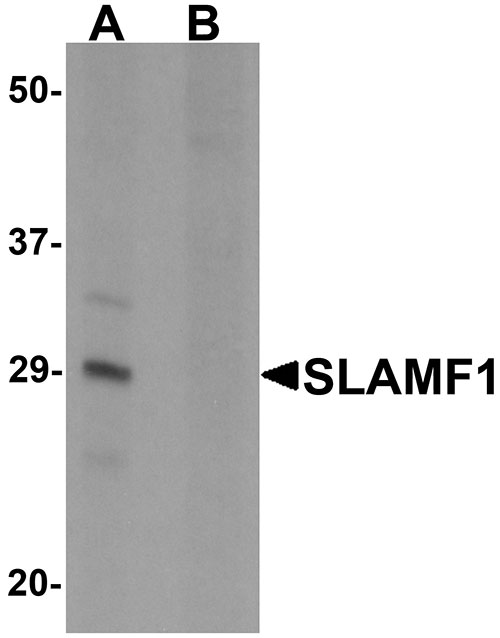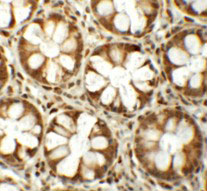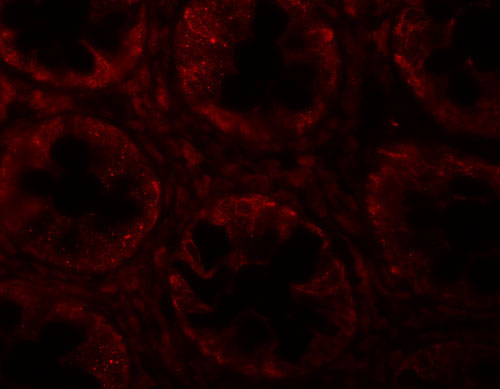SLAMF1 Antibody
- 产品详情
- 实验流程
- 背景知识
Application
| WB, IF, E, IHC-P |
|---|---|
| Primary Accession | Q13291 |
| Other Accession | NP_003028, 4506969 |
| Reactivity | Human, Mouse, Rat |
| Host | Rabbit |
| Clonality | Polyclonal |
| Isotype | IgG |
| Calculated MW | 37231 Da |
| Concentration (mg/ml) | 1 mg/mL |
| Conjugate | Unconjugated |
| Application Notes | SLAMF1 antibody can be used for detection of SLAMF1 by Western blot at 1 µg/mL. Antibody can also be used for immunohistochemistry starting at 5 µg/mL. For immunofluorescence start at 20 µg/mL. |
| Gene ID | 6504 |
|---|---|
| Other Names | Signaling lymphocytic activation molecule, CDw150, IPO-3, CD150, SLAMF1, SLAM |
| Target/Specificity | SLAMF1; Two isoforms of SLAMF1 are known to exist; this antibody will recognize both isoforms. SLAMF1 antibody is predicted to not cross-react with other SLAM protein family members. |
| Reconstitution & Storage | SLAMF1 antibody can be stored at 4℃ for three months and -20℃, stable for up to one year. As with all antibodies care should be taken to avoid repeated freeze thaw cycles. Antibodies should not be exposed to prolonged high temperatures. |
| Precautions | SLAMF1 Antibody is for research use only and not for use in diagnostic or therapeutic procedures. |
| Name | SLAMF1 |
|---|---|
| Synonyms | SLAM |
| Function | Self-ligand receptor of the signaling lymphocytic activation molecule (SLAM) family. SLAM receptors triggered by homo- or heterotypic cell-cell interactions are modulating the activation and differentiation of a wide variety of immune cells and thus are involved in the regulation and interconnection of both innate and adaptive immune response. Activities are controlled by presence or absence of small cytoplasmic adapter proteins, SH2D1A/SAP and/or SH2D1B/EAT-2. SLAMF1-induced signal-transduction events in T-lymphocytes are different from those in B-cells. Two modes of SLAMF1 signaling seem to exist: one depending on SH2D1A (and perhaps SH2D1B) and another in which protein-tyrosine phosphatase 2C (PTPN11)-dependent signal transduction operates. Initially it has been proposed that association with SH2D1A prevents binding to inhibitory effectors including INPP5D/SHIP1 and PTPN11/SHP-2 (PubMed:11806999). However, signaling is also regulated by SH2D1A which can simultaneously interact with and recruit FYN which subsequently phosphorylates and activates SLAMF1 (PubMed:12458214). Mediates IL-2-independent proliferation of activated T-cells during immune responses and induces IFN-gamma production (By similarity). Downstreaming signaling involves INPP5D, DOK1 and DOK2 leading to inhibited IFN-gamma production in T-cells, and PRKCQ, BCL10 and NFKB1 leading to increased T-cell activation and Th2 cytokine production (By similarity). Promotes T-cell receptor-induced IL-4 secretion by CD4(+) cells (By similarity). Inhibits antigen receptor- mediated production of IFN-gamma, but not IL-2, in CD4(-)/CD8(-) T- cells (By similarity). Required for IL-4 production by germinal centers T follicular helper (T(Fh))cells (By similarity). May inhibit CD40- induced signal transduction in monocyte-derived dendritic cells (PubMed:16317102). May play a role in allergic responses and may regulate allergen-induced Th2 cytokine and Th1 cytokine secretion (By similarity). In conjunction with SLAMF6 controls the transition between positive selection and the subsequent expansion and differentiation of the thymocytic natural killer T (NKT) cell lineage. Involved in the peripheral differentiation of indifferent natural killer T (iNKT) cells toward a regulatory NKT2 type (By similarity). In macrophages involved in down-regulation of IL-12, TNF-alpha and nitric oxide in response to lipopolysaccharide (LPS) (By similarity). In B-cells activates the ERK signaling pathway independently of SH2D1A but implicating both, SYK and INPP5D, and activates Akt signaling dependent on SYK and SH2D1A (By similarity). In B-cells also activates p38 MAPK and JNK1 and JNK2 (PubMed:20231852). In conjunction with CD84/SLAMF5 and SLAMF6 may be a negative regulator of the humoral immune response (By similarity). Involved in innate immune response against Gram-negative bacteria in macrophages; probably recognizes OmpC and/or OmpF on the bacterial surface, regulates phagosome maturation and recruitment of the PI3K complex II (PI3KC3-C2) leading to accumulation of PdtIns(3)P and NOX2 activity in the phagosomes (PubMed:20818396). |
| Cellular Location | Cell membrane; Single-pass type I membrane protein. Note=Present on the surface of B- cells and T-cells. Located at the plasma membrane contacts between neighboring T-cells (PubMed:11806999). [Isoform 4]: Cell membrane. Note=Overexpressed isoform 4 is detected on the cell surface. In glioma cell lines endogenuous isoform 4 is detetced predominantly in the cytoplasm and colocalized with endoplasmic reticulum and Golgi markers. |
| Tissue Location | Constitutively expressed on peripheral blood memory T-cells, T-cell clones, immature thymocytes and a proportion of B- cells, and is rapidly induced on naive T-cells after activation (PubMed:7617038). Activated B-cells express isoform 1, isoform 3 and a cytoplasmic isoform (PubMed:9091591). Isoform 4 is expressed in B- cells, primary T-cells, dendritic cells and macrophages. Isoform 4 is expressed in tumors of the central nervous system (PubMed:25710480) |
For Research Use Only. Not For Use In Diagnostic Procedures.
Provided below are standard protocols that you may find useful for product applications.
BACKGROUND
SLAMF1 Antibody: The signaling lymphocyte-activation molecule family member 1 (SLAMF1) is a novel receptor on T cells that potentiates T cell expansion in a CD28-independent manner. SLAMF1 is predominantly expressed by hematopoietic tissues. Reports suggest that the extracellular domain of SLAMF1 is the receptor for the measles virus and acts as a co-activator on both T and B cells. It is thought to interact with SH2D1A and with PTPN11 via its cytoplasmic domain. Mutations of the SLAM associated gene may be associated with X-linked lympho-proliferative disease (XLP).
REFERENCES
Cocks BG, Chang CC, Carballido JM, et al. 1995. A novel receptor involved in T cell activation. Nature 1995; 376:260-3.
Tatsuo H, Ono N, Tanaka K, et al. SLAM (CDw150) is a cellular receptor for measles virus. Nature 2000; 406:893-7.
Aversa G, Chang CC, Carballido JM, et al. Engagement of the signaling lymphocytic activation molecule (SLAM) on activated T cells results in IL-2-independent, Cyclosporin A-sensitive T cell proliferation and IFN-α production. J. Immunol. 1997; 158:4036-44.
终于等到您。ABCEPTA(百远生物)抗体产品。
点击下方“我要评价 ”按钮提交您的反馈信息,您的反馈和评价是我们最宝贵的财富之一,
我们将在1-3个工作日内处理您的反馈信息。
如有疑问,联系:0512-88856768 tech-china@abcepta.com.























 癌症的基本特征包括细胞增殖、血管生成、迁移、凋亡逃避机制和细胞永生等。找到癌症发生过程中这些通路的关键标记物和对应的抗体用于检测至关重要。
癌症的基本特征包括细胞增殖、血管生成、迁移、凋亡逃避机制和细胞永生等。找到癌症发生过程中这些通路的关键标记物和对应的抗体用于检测至关重要。 为您推荐一个泛素化位点预测神器——泛素化分析工具,可以为您的蛋白的泛素化位点作出预测和评分。
为您推荐一个泛素化位点预测神器——泛素化分析工具,可以为您的蛋白的泛素化位点作出预测和评分。 细胞自噬受体图形绘图工具为你的蛋白的细胞受体结合位点作出预测和评分,识别结合到自噬通路中的蛋白是非常重要的,便于让我们理解自噬在正常生理、病理过程中的作用,如发育、细胞分化、神经退化性疾病、压力条件下、感染和癌症。
细胞自噬受体图形绘图工具为你的蛋白的细胞受体结合位点作出预测和评分,识别结合到自噬通路中的蛋白是非常重要的,便于让我们理解自噬在正常生理、病理过程中的作用,如发育、细胞分化、神经退化性疾病、压力条件下、感染和癌症。








